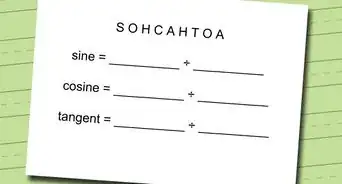This article was co-authored by Natalia S. David, PsyD. Dr. David is an Assistant Professor in Psychology at the University of Texas Southwestern Medical Center and a Psychiatry Consultant at Clements University Hospital and at Zale Lipshy University Hospital. She is a member of the Board of Behavioral Sleep Medicine, the Academy for Integrative Pain Management, and the American Psychological Association’s Division of Health Psychology. In 2017, she received the Baylor Scott & White Research Institute’s Podium Presentation Award and scholarship. She received her PsyD from Alliant International University in 2017 with an emphasis in Health Psychology.
There are 8 references cited in this article, which can be found at the bottom of the page.
This article has been viewed 21,647 times.
The Self-Administered Gerocognitive Examination (or SAGE test) is a 15-question written exam used to test your memory. This test can be very effective in detecting mild cognitive impairment (MCI), early dementia, and early Alzheimer’s, but only a medical professional can interpret your results and make a diagnosis. Begin by learning about the SAGE test and deciding to take it. You can then take the test in around 15 minutes, and present your results to your doctor. Together, you and your doctor can work to diagnose any cognitive conditions.[1]
Steps
Deciding to Take the Test
-
1Look for symptoms. You might be interested in taking the SAGE test if you are experiencing some memory or thinking problems, or if friends and family are concerned that you may have cognitive issues. Cognitive symptoms can indicate early dementia or Alzheimer’s, as well as many other treatable conditions.[2] These symptoms include:[3]
- Memory loss (forgetting things like names, conversations, or where you put things)
- Losing track of time (forgetting the day of the week or the date)
- Sudden changes in mood
- Executive impairment (struggling with decision making and organization, or using poor judgment)
- Impaired sense of direction (getting lost in places that are familiar)
-
2Don’t expect definitive answers. Before you even begin, it is important to understand that the SAGE test does not diagnose any specific disorder. It cannot tell you if you have Alzheimer’s, dementia, or any other condition. It is only a screening tool that allows your doctor to determine if additional tests are necessary. Do not use this test to try and diagnose yourself.[4]Advertisement
-
3Anticipate certain types of questions. There are four different versions of the SAGE test, and all of these are interchangeable. They will all ask a variety of questions. The test may be something like the following:[5]
- You will start by filling out some personal information and medical history.
- There will be some image questions. You will be shown an image (such as a pretzel or wreath) and you will be asked to write down the word for that image.
- There will be some math questions, such as “How many nickels are in $2.00?”
- There will be questions concerning the similarities and differences between certain items, such as “How are a ruler and clock similar?”
- There will some drawing questions. There may be a question where you must look at an image and copy it. There may also be questions where you must look at an image and draw it differently, based on a set of instructions.
- There may be memory-based questions where you must remember to perform an action at the end of the exam.
Taking the Test
-
1Print out a copy of the test. You can obtain a copy of the SAGE test and take it in the privacy of your home. Visit https://wexnermedical.osu.edu/brain-spine-neuro/memory-disorders/sage to find four interchangeable versions of the exam. Alternatively, your doctor can provide you with a copy of the test, and you can take at home or in the office.[6]
- You can also complete the test online using a tablet or computer and email the results to your doctor. This may be the most convenient option.
- Ideally you would take the test at your doctor's office, but it is okay to take it at home, especially if being at the doctor's causes you anxiety.
-
2Set aside some time. Most participants can finish the exam in 10 – 15 minutes, but there is no time limit. Set aside a block of time when you can take as much time as you need without being disturbed.[7]
- You should also choose an area free from distractions.
- Find a quiet place where you will not be disturbed.
-
3Complete the test without outside input. It is important for you to complete this test without help from anyone or anything. Before you begin, move any clocks, rulers, or calendars out of the space. If you don’t understand an aspect of the test, simply do the best you can. Do not ask questions or seek input from others.[8]
Determining the Results
-
1Avoid scoring the test yourself. There are numerous acceptable answers to SAGE test questions, and only a medical professional can score your test accurately. Online versions of the test that provide answer sheets or offer to electronically grade your test should be avoided.[9]
-
2Ask your doctor to score your test. Speak to your doctor about looking over the results of your test. If you have taken the test at home, you might fax, email, or deliver your test in person. Your doctor may request additional information about your symptoms and medical history.[10] Be prepared to discuss:
- When your symptoms began
- Descriptions of your symptoms
- Your medical history, as well any history of memory disorders in your family
-
3Visit your doctor. You will meet with your doctor to discuss your results. This test alone cannot diagnose any specific condition. As such, your doctor might schedule some additional tests. If your results come back “normal,” your doctor may choose to keep your results on file to see if there are any chances in the future.[11]
- You may ask your doctor, "Do my results seem accurate to you?"
- You might ask, "Am I at risk for mild cognitive disorder?"
- You might ask, "What other tests do you think we should explore?"
References
- ↑ https://alzres.biomedcentral.com/articles/10.1186/s13195-021-00930-4
- ↑ https://wexnermedical.osu.edu/brain-spine-neuro/memory-disorders/sage
- ↑ https://www.nia.nih.gov/health/what-are-signs-alzheimers-disease
- ↑ https://wexnermedical.osu.edu/brain-spine-neuro/memory-disorders/sage
- ↑ https://dailycaring.com/sage-test-for-alzheimers-at-home/
- ↑ https://wexnermedical.osu.edu/brain-spine-neuro/memory-disorders/sage/download-the-sage-test
- ↑ https://wexnermedical.osu.edu/brain-spine-neuro/memory-disorders/sage
- ↑ https://alzres.biomedcentral.com/articles/10.1186/s13195-021-00930-4
- ↑ https://www.dementiacarecentral.com/self-administered-gerocognitive-exam/





































































Medical Disclaimer
The content of this article is not intended to be a substitute for professional medical advice, examination, diagnosis, or treatment. You should always contact your doctor or other qualified healthcare professional before starting, changing, or stopping any kind of health treatment.
Read More...